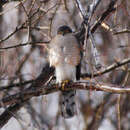Description: Stability flapping in a wild Eurasian Sparrowhawk (Accipiter nisus). The vigorous flapping of this sparrowhawk is not an attempt to fly away with its prey. Rather, this is “stability flapping”: employed only to get on top of the prey and maintain this position so that the raptor can use its bodyweight to pin down its victim. With the feet employed in preventing escape, the forelimbs must now be used to maintain an advantageous position: the opposite to what is seen in basal theropods where the forelimbs presumably had a greater role in subduing prey, with the feet used for positioning. 0:54: Prey positioning. Here the sparrowhawk has the prey pinned between its D-II talons, with the other toes used for stable footing. Even though its victim is still alive, the raptor can continue to feed as the prey is well restrained by the predator's bodyweight and claws. Light stability flapping is intermittently employed to maintain position. Filmed 12th March 1998, Nacton, Suffolk, UK. Date: 1998/2011. Source:
http://www.plosone.org/article/info%3Adoi%2F10.1371%2Fjournal.pone.0028964. Author: John Norris.

